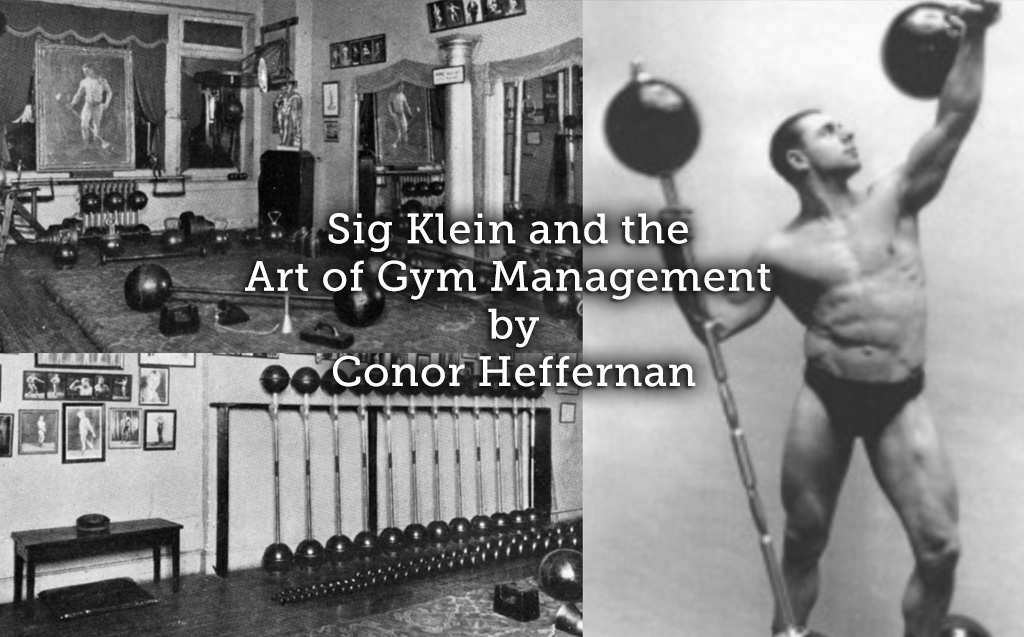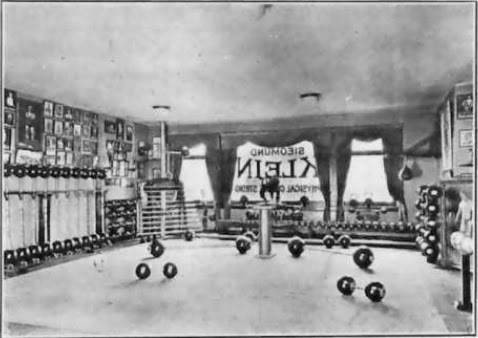Operating in the first half of the twentieth-century in his plush New York Gymnasium, Sig Klein was one of America’s most respected and highly sought-after trainers during a several decade career which witnessed the German born émigré run a highly successful gym, publish his own bodybuilding journal and amass a beer stein collection totalling over two hundred steins. Though weighing significantly less than the traditional circus strongman, Klein boasted a strength which rivalled many of his contemporary bodybuilders or physical culturists as they were classed in the early 1900s. At a time when owning a gymnasium was still a new and often volatile career, Klein distinguished himself as a shrewd and successful businessman.
Established in the mid-1920s and located at 717 Seventh Avenue, Klein’s gymnasium was renowned for its unique and rare equipment. At a time when heavy weight training was still taboo, a point previously noted by Todd, Klein’s gymnasium was stocked with barbells and dumbbells ranging from light to ludicrous weights. Thriving during the Great Depression of 1929, Klein’s gymnasium forged a reputation as a bodybuilding haven for both serious and lackadaisical trainers. Indeed, such was the esteem with which Klein’s gym was held in the bodybuilding community that it regularly featured in the magazines of Joe Weider, the man oftentimes credited with uncovering Arnold Schwarzenegger’s celebrity. In this way, it is possible to credit Klein as a forerunner to the current health and fitness climate of contract only gymnasiums, gymnasiums catering to specialised populations or those for the general public. It is for this reason that Klein’s ruminations on successful gym management, written sometime during the 1930s and hidden amongst his personal papers in the Stark Center make for such interesting reading. Though gym management was still in its infancy, Klein displayed a remarkable foresight and some would argue cynicism regarding the industry. The purpose of the present post is to highlight Stein’s multifaceted approach to gym management.
In the first instance, Klein was keenly aware of the value of self-promotion. Though described as humble by his many contemporaries, his business notes stressed the importance of the individual in running a successful gymnasium. Prospective gym owners were thus told that it was important for gym managers to set a personal example for his members to emulate. Included in this was Klein’s assertion that the manager must occasionally defeat their stronger members in informal weightlifting competitions so as to retain a certain awe and respect amongst his patrons. Summed up, Klein asserted that ‘your own physical perfection must back your health claims.’ Member’s physical perfection could be similarly harnessed for promotional purposes. Anticipating the remarkable physique transformations used to promote certain systems of exercise or gymnasiums, Klein believed that once clients had lost weight or gained muscle, that they too should become informal representatives of the gymnasium. Thus in choosing a location, he recommended that new owners ensure that they have
‘A large glass enclosed frame next to your street entrance in which you can display pictures of yourself and perhaps one or two photos of your best developed pupils…’
In a similar vein, Klein stressed the importance of public exhibitions of strength as a means of promoting the gymnasium. Such exhibitions would feature the gym owner and several of their strongest clients performing a variety of exercises with seemingly implausible weights. Klein strongly believed that the combination of individual and group exhibitions would help ‘lure people from other gymnasiums.’
- Klein’s Gymnasium c. 1930.
Promotional prowess was nothing however without an attractive location. Cognisant of rental costs, a point no doubt influenced by his own New York premises, Klein nevertheless stressed the importance of securing the right location even if that meant incurring some additional costs. Individuals were thus informed that ‘some form of convenience’ was important in encouraging individuals to regularly attend the gym. At a time when female weightlifting classes were almost non-existent in the United States, save the exception of a few individuals, Klein’s dictates in this regard were directly aimed at attracting male customers. Thus, a location with ‘a preponderance of women’s shops’ was discouraged as men were ‘not likely to frequent that sort of street.’ Much better, according to Klein, was a theatre street or any locality were ‘men were known to congregate.’
Once a suitable location had been found, equipment needed to be purchased. Illustrating the importance of appealing to the broadest number of people as possible, Klein firmly believed that gymnasiums needed to provide weights light enough to encourage the beginner and heavy enough to test the experienced. Gymnasiums were expected then to provide barbells and dumbbells weighing from five to fifty pounds for the former and barbells weighing up to four hundred pounds for the latter. Displaying a remarkable eye for detail Klein stressed the importance of keeping the equipment bright, clean and organised. Doing so would ‘add so much lustre to your reputation as well as your barbells.’ As the below image demonstrates, Klein’s own gymnasium was modelled upon this advice. Barbells littered the floor only when in use and were set aside outside of classes.
Highlighting the sparsity of available gym equipment, at least compared to modern gymnasiums which boast a variety of ropes, machines and weights, Klein focused primarily upon the acquisition of dumbbells and barbells, a point he noted could provide problems for those whose gymnasiums were not located on a ground floor. At the turn of the century, the famous Prussian strongman Eugen Sandow, briefly became the subject of great mockery following a court case with his landlord. Unbeknownst to the property owner, Sandow had attempted to use his weightlifting equipment in the building’s first floor. Following a particularly heavy exercise, Sandow dropped his weights to the ground which broke through the floor boards to the lower levels. It was for this reason that Klein advised readers that good flooring in the gymnasium was not only important but essential. Pointing out the importance of aesthetics, Klein finished his recommendations in this regard by advising new owners to adorn their gymnasiums with photographs of strongman and particularly strong clients. Such photographs would not only act as inspiration for trainees but would also, it was hoped, provide a nice finish to the building.
The final and arguably most important aspect of running a gymnasium which Klein dealt with was the importance of profit making. In the first instance Klein detailed several small ways in which gym owners could make a small profit. Owners were thus encouraged to offer small amenities in the gymnasium such as towels, jock straps, razor blades etc. which could be purchased at wholesale prices and sold at a premium. Large margins on small items were one way Klein believed gym owners could supplement their income. In terms of membership sales, Klein recounted his own best practice. In the first instance discounts were offered to members who encouraged friends and family members to join the gymnasium. Similarly, local sporting clubs were targeted and offered reduced rates for entire teams. In such promotions Klein targeted both the ‘young men and boys who want to build up big muscles and older mean who recognise an increasing corpulence and want to reduce.’ Once a prospective client entered the gymnasium Klein would be ‘pleasant’ in showing them around the space, enquiring as to their motives and then demonstrating how the gymnasium would help them achieve their goals. Thus, depending on the client, the gymnasium was a weight loss centre, a health clinic or a den of muscle building. For the timid, Klein discouraged the idea that all his work was done with heavy weights. For the athlete Klein stressed the champion sportsmen he had trained. Once more existing clients were used as examples to entice prospective clients. In terms of his sales approach, Klein attempted to enamour individuals with the gymnasium before bringing up the issue of cost. Klein’s readers were told therefore to
Bring up rates at the end… the more your prospect can absorb about your systems and its benefits before he stumbles over the cost the better…
While different payments schemes could be utilised to attract clients, Klein was forthright in his belief that the individual salesman was pivotal in this regard.
Successfully operating his gymnasium for several decades, Klein’s business prescriptions provide a fascinating insight into the art of gym management in mid-twentieth century America. While studies of physical culture and bodybuilding during this period have previously focused on the marketing of equipment or workout courses, few scholars have examined the running of gymnasiums in any great detail. Klein’s gymnasium dictates highlight the importance that such a study could provide as in them one finds broader commercial and gender messages. Regarding the former, Klein’s advice stressed the importance of a welcoming and inviting atmosphere for consumers which could help them achieve nebulous self-imposed goals. Regular attendance at the gymnasium was influenced by the ease of location as well as the perception that the gym was professional and clean. Gym goers in this era were a diverse group of individuals but they, at least in Klein’s mind, adhered to certain trends. In discussions of gender, Klein dealt solely with American men, many of whom were discontent with their bodies. For the younger generation Klein identified a great anxiety about building their physiques and obtaining noticeable musculature. For men in their mid-life, fears of excess corpulence were seen to be a driving motivation. In this way Klein identified changes in the life-cycle regarding men’s perceptions of desirable bodies. Where the teenager wanted muscles, the businessman wanted to appear trim. Regardless of age, neither group would countenance attending a gymnasium located in a predominately women’s shopping district. Male images and male sociability thus mattered. Though concerned with operating at a profit, Klein’s advice told much about American consumption, leisure and masculinity.
Article © Conor Heffernan
Reference List
Sig Klein, ‘Physical Culture: A Pleasant and Profitable Profession’ (Sig Klein Collection, Undated, The H.J. Lutcher Stark Center For Physical Culture and Sports).









![Introduction to the British Society of Sports History [BSSH]](https://www.playingpasts.co.uk/wp-content/uploads/2021/03/Bssh-Banner-440x264.png)